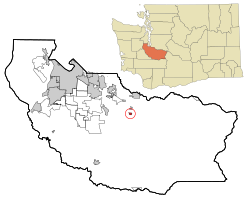Carbonado, Washington
| Carbonado, Washington | |
|---|---|
| Town | |

Welcome sign in Carbonado
|
|
 Location of Carbonado, Washington |
|
| Coordinates: 47°4′47″N 122°3′5″W / 47.07972°N 122.05139°WCoordinates: 47°4′47″N 122°3′5″W / 47.07972°N 122.05139°W | |
| Country | United States |
| State | Washington |
| County | Pierce |
| Area | |
| • Total | 0.42 sq mi (1.09 km2) |
| • Land | 0.42 sq mi (1.09 km2) |
| • Water | 0 sq mi (0 km2) |
| Elevation | 1,191 ft (363 m) |
| Population (2010) | |
| • Total | 610 |
| • Estimate (2015) | 625 |
| • Density | 1,452.4/sq mi (560.8/km2) |
| Time zone | Pacific (PST) (UTC-8) |
| • Summer (DST) | PDT (UTC-7) |
| ZIP code | 98323 |
| Area code(s) | 360 |
| FIPS code | 53-09970 |
| GNIS feature ID | 1517390 |
Carbonado is a town in Pierce County, Washington, United States. Carbonado is located near the Carbon River in northern Pierce County, approximately 50 miles (80 km) southeast of Seattle and 12 miles (19 km) northwest of Mount Rainier National Park. Carbonado served as an important coal mining community in the late nineteenth and early twentieth centuries, when the town operated the largest coal mine in Pierce County. The population was 610 at the 2010 census.
Carbonado was one of quite a few towns in the Carbon River valley to be settled during an economic boom in the region. The boom was brought on by raw material demands in nearby growing towns such as Seattle and Tacoma. Starting with the town of Burnett and moving on through Wilkeson, Carbonado, Montezuma, Fairfax, and finally Manley Moore, these settlements sprawled up the valley to the very boundary of Mount Rainier National Park. Most of these towns were company towns, meaning that they specialized in the harvest of raw materials owned the plot of land that the town was situated on and that the resources were harvested from. Often—and such was the case of Carbonado—the company also owned the houses and the energy resources as well. The energy resource in Carbonado was also the raw material that the citizens of the company town were harvesting, coal.
During the time of the initial boom in the valley Carbonado grew to rival the size of Tacoma at the time. The railroad, which was integral to the transportation of people, of the raw materials harvested and the supplies need by the towns, stretched all the way up the valley too. Not only did it service the towns but also several homesteads farther up the valley. These homesteads were settled predominantly by Polish immigrants. They supplied the towns down the valley with fresh milk and eggs. Two survive to present day, one known as Carbon River Ranch (the main house is the old Fairfax school and can be seen from the highway) and the other formerly known as Huckle-Chuck. At Huckle-Chuck the original homesteaders house and one of their barns are still used and functional. At the peak of the boom both of these homesteads and the towns which they supplied were quite productive and lively.
...
Wikipedia
